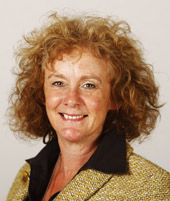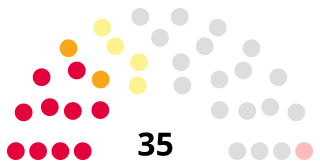
Dumfries and Galloway is one of the 32 unitary council areas of Scotland, located in the western part of the Southern Uplands. It is bordered by East Ayrshire, South Ayrshire, and South Lanarkshire to the north; Scottish Borders to the north-east; the English county of Cumbria, the Solway Firth, and the Irish Sea to the south, and the North Channel to the west. The administrative centre and largest settlement is the town of Dumfries. The second largest town is Stranraer, located 76 miles (122 km) to the west of Dumfries on the North Channel coast.

Russell Leslie Brown is a Scottish Labour Party politician. He is a former Member of Parliament (MP) for Dumfriesshire (1997–2005) and Dumfries and Galloway (2005–2015). He lost his seat at the 2015 general election to Richard Arkless of the Scottish National Party.

Dumfries and Galloway is a constituency in Scotland represented in the House of Commons of the UK Parliament by John Cooper of the Scottish Conservatives since the 2024 general election. It was first contested in the 2005 general election, replacing Galloway and Upper Nithsdale and part of Dumfries. Like all British constituencies, it elects one Member of Parliament (MP) by the first-past-the-post system of election. Despite its name, it does not cover the whole of the Dumfries and Galloway council area.

Dumfriesshire, Clydesdale and Tweeddale is a constituency of the House of Commons, located in the South of Scotland, within the Dumfries and Galloway, South Lanarkshire and Scottish Borders council areas. It elects one Member of Parliament (MP) at least once every five years using the First-past-the-post system of voting. It is currently represented in Westminster by the former Secretary of State for Scotland, David Mundell, a Conservative, who has been the MP since 2005.

David Gordon Mundell, is a Scottish Conservative Party politician and solicitor who has served as Member of Parliament (MP) for Dumfresshire, Clydesdale and Tweeddale since 2005. He previously served as Secretary of State for Scotland from 2015 to 2019. Mundell was the first openly gay Conservative cabinet minister, coming out in 2016.

Carrick, Cumnock and Doon Valley is a county constituency of the Scottish Parliament at Holyrood, covering parts of the council areas of South Ayrshire and East Ayrshire. It elects one Member of the Scottish Parliament (MSP) by the plurality method of election. Also, it is one of nine constituencies in the South Scotland electoral region, which elects seven additional members, in addition to the nine constituency MSPs, to produce a form of proportional representation for the region as a whole.

Elaine Kildare Murray is a retired Scottish Labour politician. She was leader of Dumfries and Galloway Council for the 2017–2022 term. She was also the Member of the Scottish Parliament (MSP) for Dumfries from 1999 to 2011, and then for Dumfriesshire from 2011 to 2016. At the 1999, 2003 and 2007 elections, Murray increased her percentage share of the vote. She was Shadow Minister for the Environment in the Scottish Parliament. She lost her seat in 2016.
George Henry Thompson was a Scottish National Party politician and Roman Catholic priest. He served as the Member of Parliament for Galloway from October 1974–79.

The 2011 Scottish Parliament election was held on Thursday, 5 May 2011 to elect 129 members to the Scottish Parliament.
Elections to Dumfries and Galloway Council were held on 3 May 2007 the same day as the other Scottish local government elections and the Scottish Parliament general election. The election was the first one using 13 new wards created as a result of the Local Governance (Scotland) Act 2004, each ward will elect three or four councillors using the single transferable vote system form of proportional representation. The new wards replace 47 single-member wards which used the plurality system of election.

Galloway and West Dumfries is a constituency of the Scottish Parliament (Holyrood) covering part of the council area of Dumfries and Galloway. It elects one Member of the Scottish Parliament (MSP) by the plurality method of election. It is also one of nine constituencies in the South Scotland electoral region, which elects seven additional members, in addition to the nine constituency MSPs, to produce a form of proportional representation for the region as a whole.

Regional elections were held in Scotland on 5 May 1994, as part of the Local Government (Scotland) Act 1973. These were the last elections before 29 new mainland unitary authorities, established by the Local Government etc. (Scotland) Act 1994, came into effect. The councils up for election were last contested in 1990 Scottish regional elections, and vote and seat changes are compared to the 1990 results.

Regional elections were held in Scotland on Thursday 8 May 1986, under the terms of the Local Government (Scotland) Act 1973. The previous elections had been held in 1982. The elections took place a year before the Conservative's third general election victory. Elections took place in England and Wales on the same day.
Richard Lambert Thomas Arkless is a Scottish National Party politician, who was elected as MP for Dumfries and Galloway at the 2015 UK general election. He lost his seat at the following election in 2017.

Elections to Strathclyde Regional Council were held on Thursday 8 May 1986, on the same day as the eight other Scottish regional elections. This was the fourth election to the regional council following the local government reforms in the 1970s.

Finlay Hamilton Carson is a Scottish Conservative Party politician serving as Convener of the Rural Affairs, Islands and Natural Environment Committee since 2021. He has been the Member of the Scottish Parliament (MSP) for the Galloway and West Dumfries since 2016.

Sir Alister William Jack is a Scottish politician who served as Secretary of State for Scotland from 2019 to 2024. A member of the Scottish Conservatives, he served as Member of Parliament (MP) for Dumfries and Galloway from 2017 to 2024.

The 1994 Dumfries and Galloway Regional Council election, the sixth and final election to Dumfries and Galloway Regional Council, was held on 5 May 1994 as part of the wider 1994 Scottish regional elections. The election saw Independents take the most seats, although they lost their overall majority.

The 1990 Dumfries and Galloway Regional Council election, the fifth election to Dumfries and Galloway Regional Council, was held on 3 May 1990 as part of the wider 1990 Scottish regional elections. The election saw the Independents' majority cut to 1 councillor, but enough to keep control of the 35 seat council.

Elections to Dumfries and Galloway Council took place on 5 May 2022 on the same day as the 31 other Scottish local government elections. As with other Scottish council elections, it was held using single transferable vote (STV) – a form of proportional representation – in which multiple candidates are elected in each ward and voters rank candidates in order of preference.














